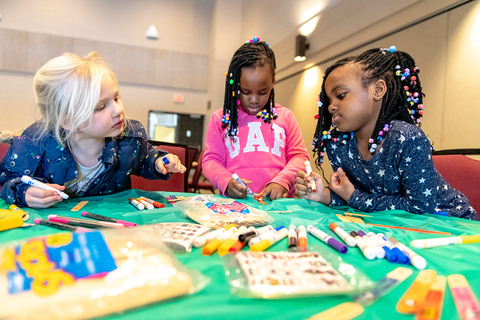If so, please let us know by filling out this short survey.
Welcome to the wonderful world of Cloverbuds!
4-H volunteers, start here to gain a better understanding of working with Cloverbuds, our youngest 4-H'ers.
The four videos in this 4-H volunteer training series are designed to support you in working with Cloverbuds (youth in grades K-2, typically 5-8 year-olds).
For the best experience, complete the videos in order. Begin by watching videos 1 and 2 for an overview of this role and the many ways Cloverbuds learn in 4-H. Then, choose videos 3 or 4, depending on your interests and the type of Cloverbud group you work with.
Training resources
Before viewing the videos, you are encouraged to download:
Apply the learning guide to note your ideas and questions with each video.
Ages and stages of youth development: Ages 5-8 handout as a helpful resource for working with youth this age.
Connect with your local 4-H office to learn more about this volunteer role in your local program.
1. Introduction
For all volunteers.
In this introduction, you will learn about the topics and key features of each of the four videos in this series. This introduction will help you plan your viewing to support your role working with Cloverbuds.
You will:
Learn who Cloverbuds are in 4-H.
Find ways to use the experiential learning model with this age group.
Gain an understanding of the essential elements of positive youth development.
Discover how this training series will support your volunteer work.
2. How Cloverbuds learn
For all volunteers.
Understanding how Cloverbuds learn is essential. This video focuses on the developmental stages of 5-8 year-olds. You will see and hear examples of how you can work with Cloverbuds to best support their physical, cognitive, social, and emotional development. It is recommended for all volunteer leaders.
You will:
- Understand the experiential learning model.
- Identify the developmental characteristics of Cloverbuds.
- Implement age-appropriate activities (ages 5-8).
3. Working with Cloverbud groups
For volunteers working with Cloverbud-specific groups.
This video explores effective practices in settings where all the youth are Cloverbuds. This may include day camps, Cloverbud clubs, afterschool programs or any program created for youth in grades K-2. You will hear ideas, tips, and strategies to support you in leading this age group.
You will:
- Apply the essential elements of positive youth development to Cloverbud-specific programming.
- Design a program specifically for the Cloverbud age group.
- Build excitement for working with Cloverbuds in 4-H programs.
4. Working with Cloverbuds in multi-age groups
For volunteers working with multi-age groups.
Cloverbuds are often part of a larger group with a wide age range, such as a 4-H club. This video supports volunteers who work with multi-age groups. You will learn ways to plan for and ensure that all youth in a multi-age group can learn, lead and grow together. You’ll see several multi-age clubs and identify effective ways to support Cloverbuds in these settings.
You will:
- Discover the importance of including Cloverbuds in your club planning.
- Identify the best ways to work with Cloverbuds in your club.
- Explore ways to create learning opportunities involving Cloverbuds.


